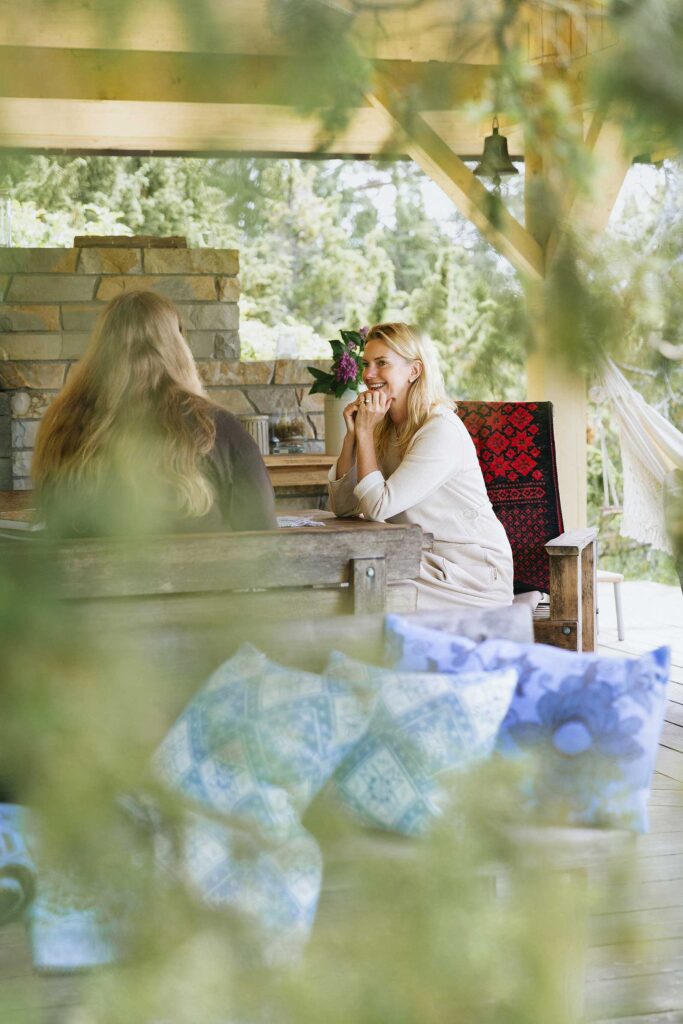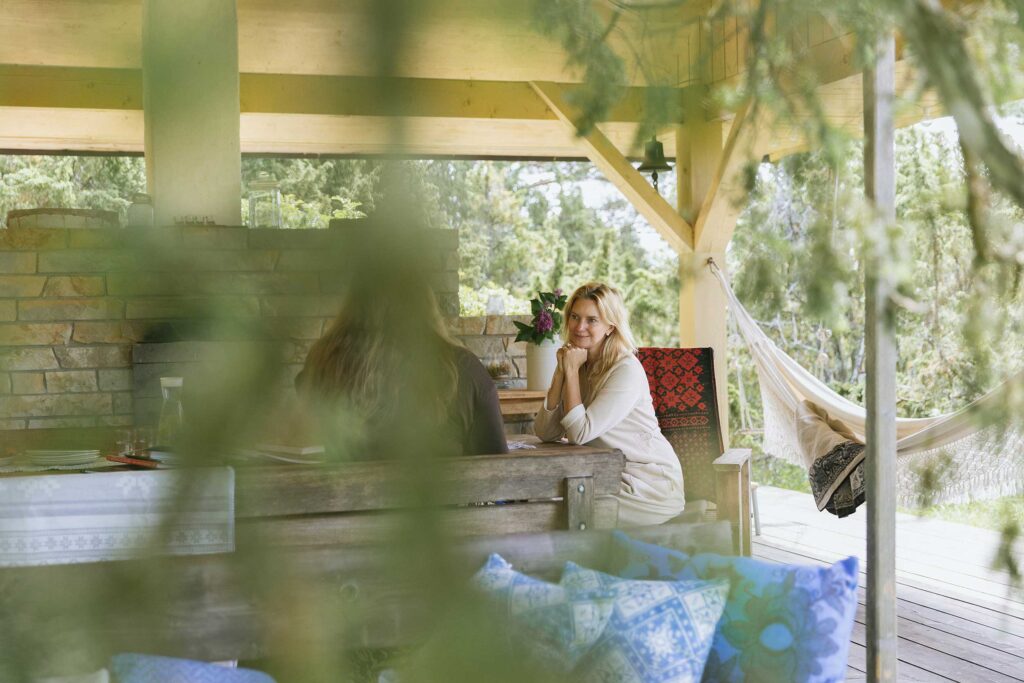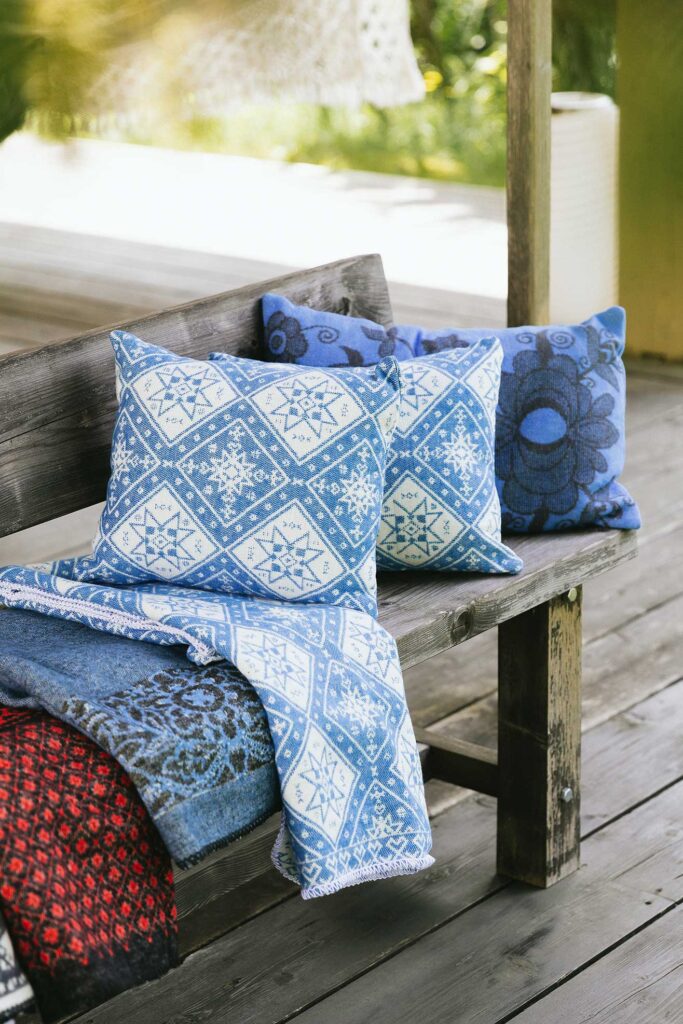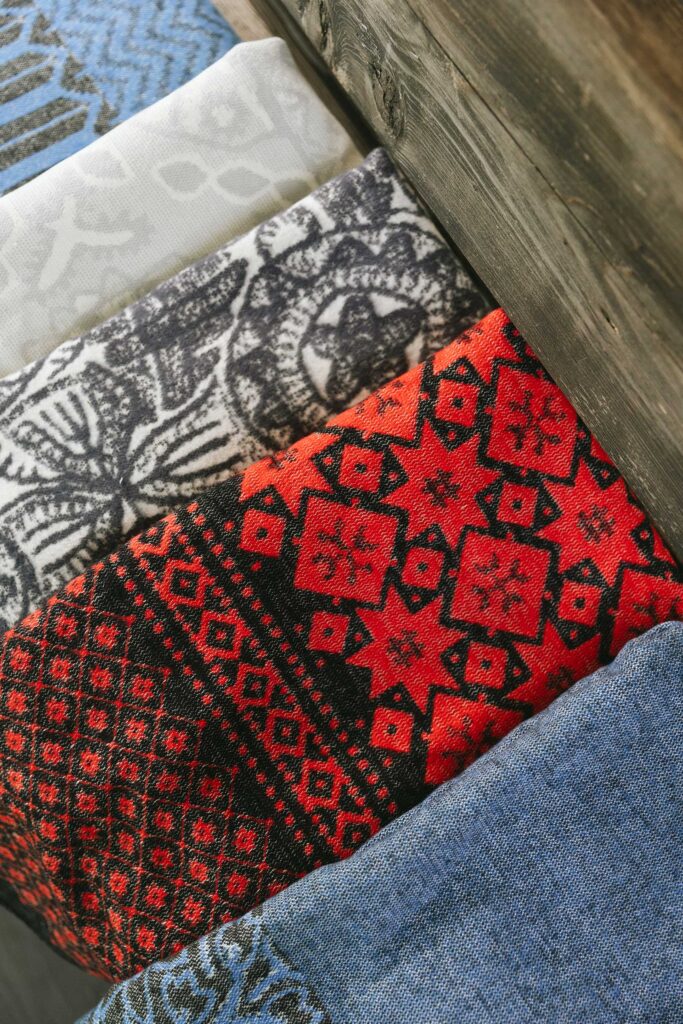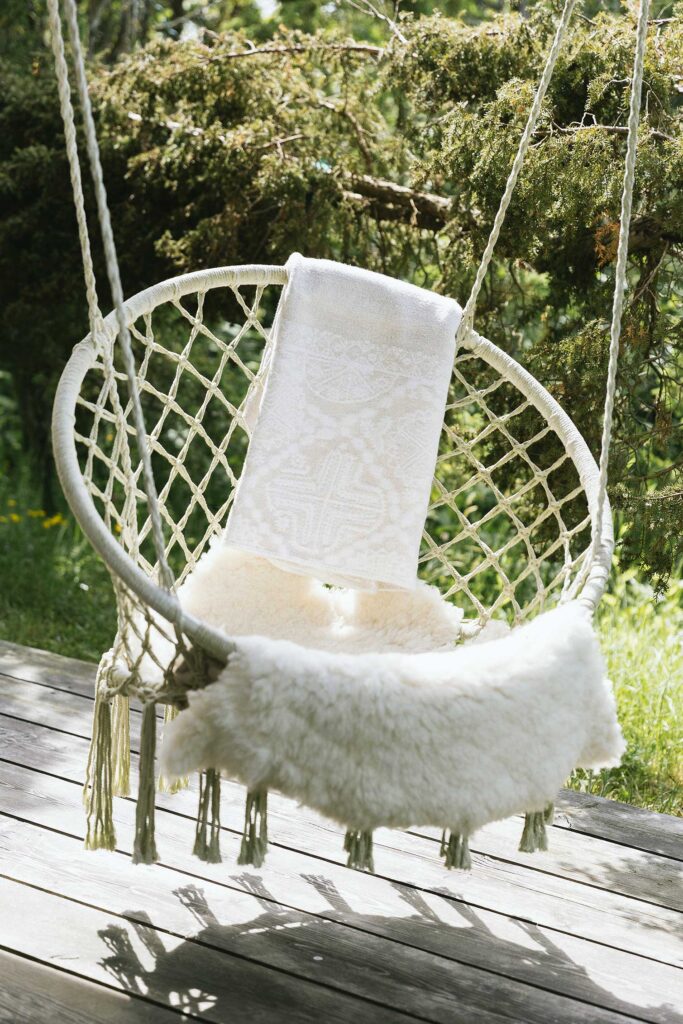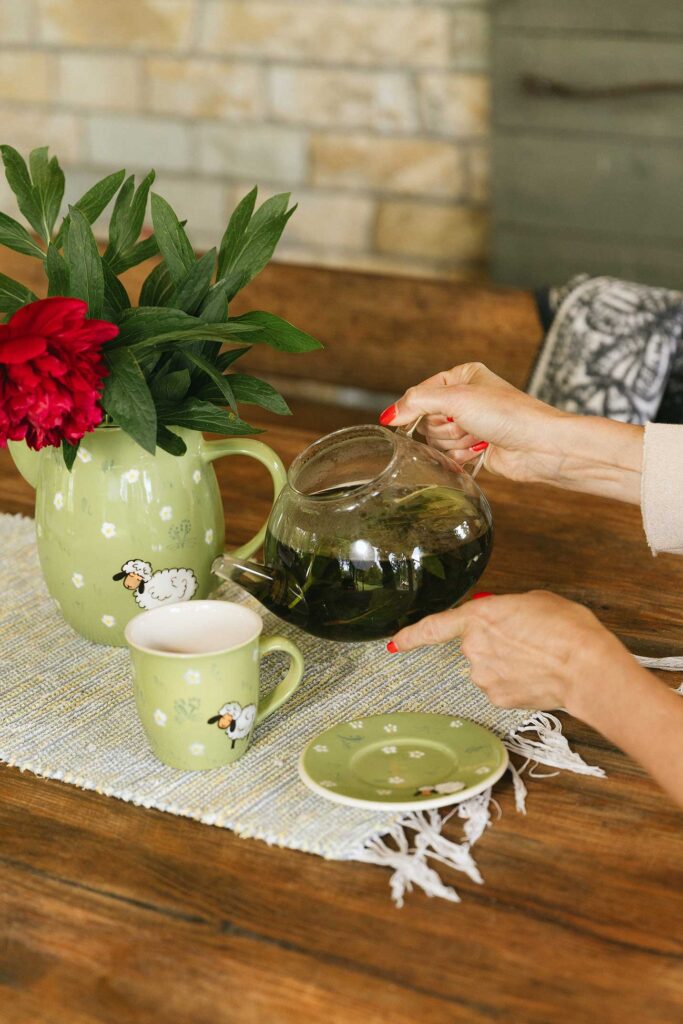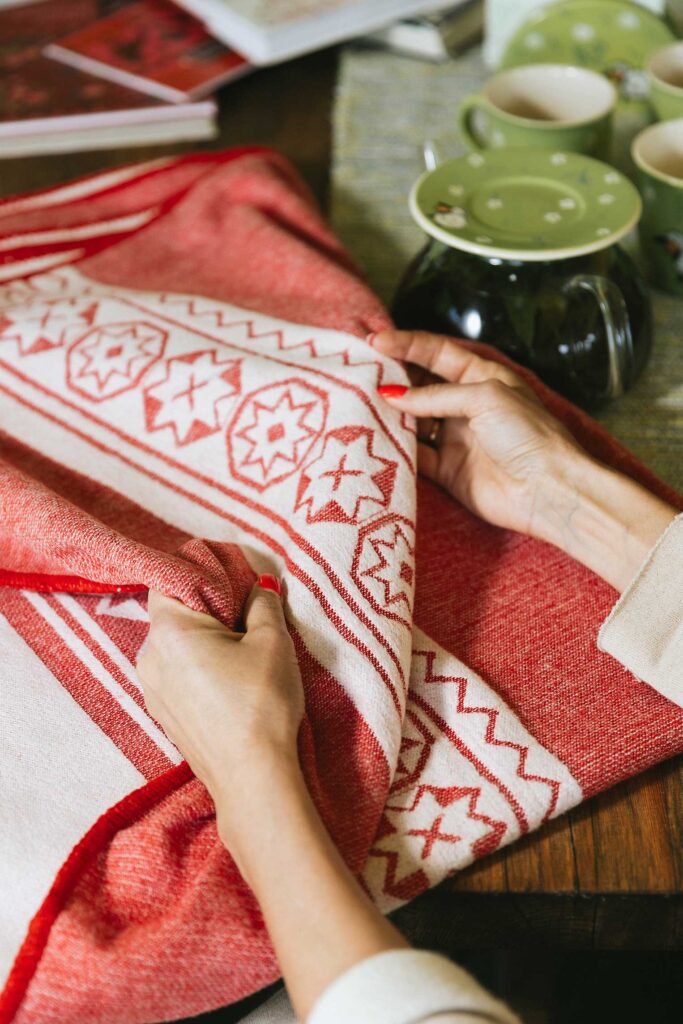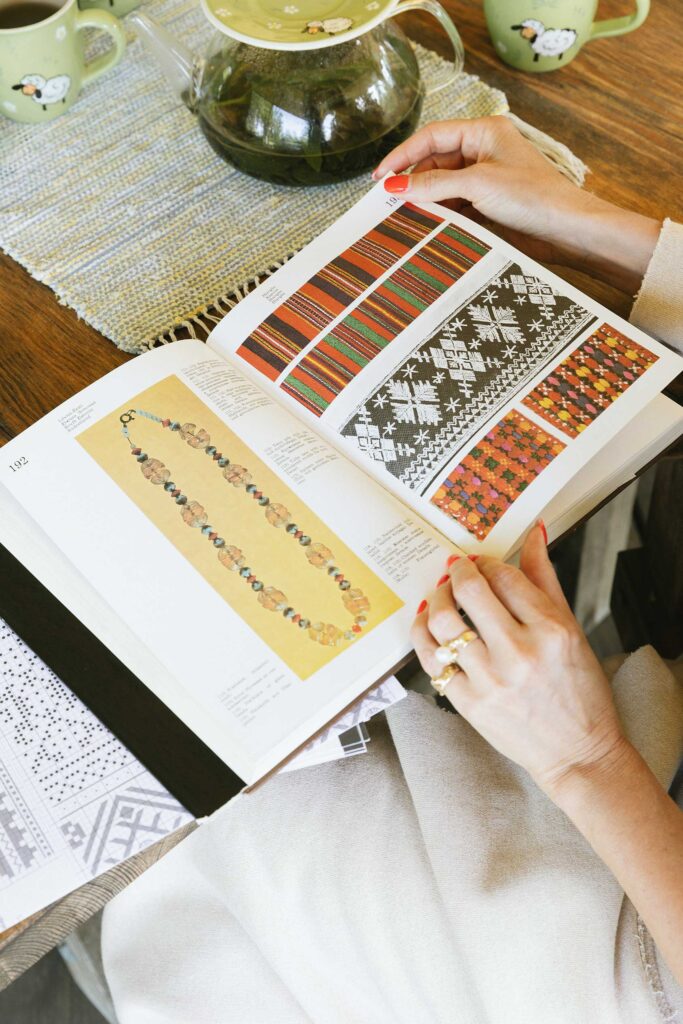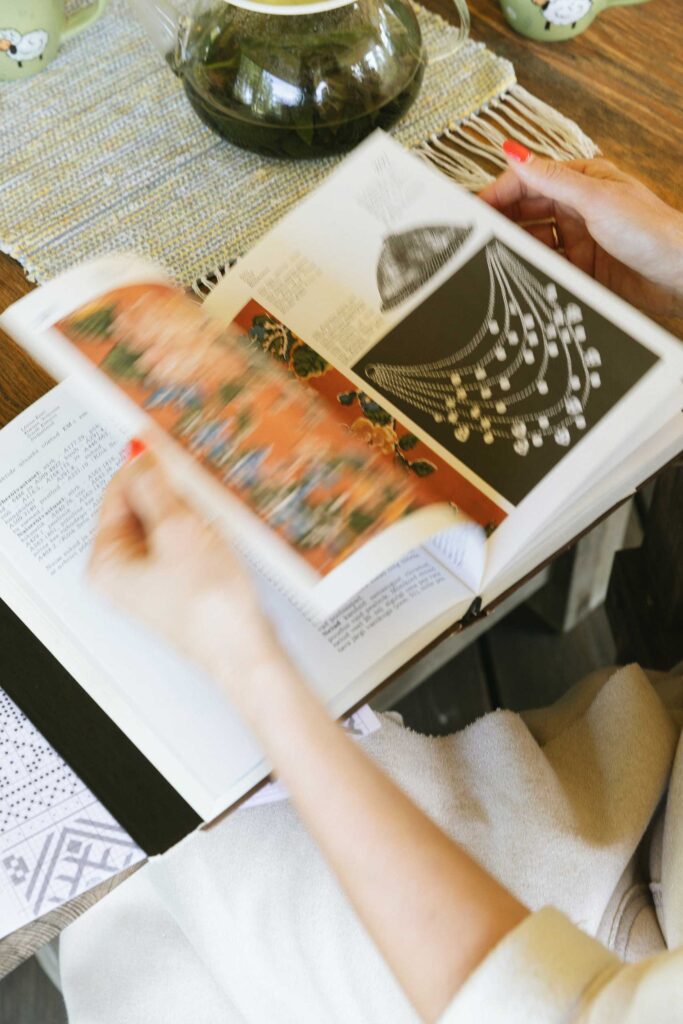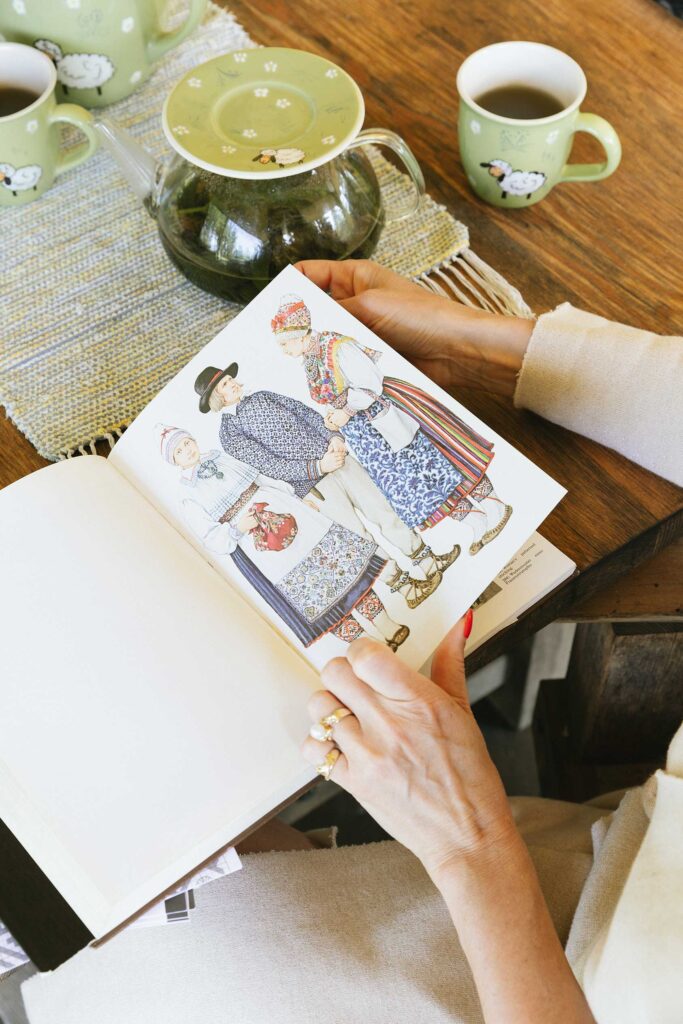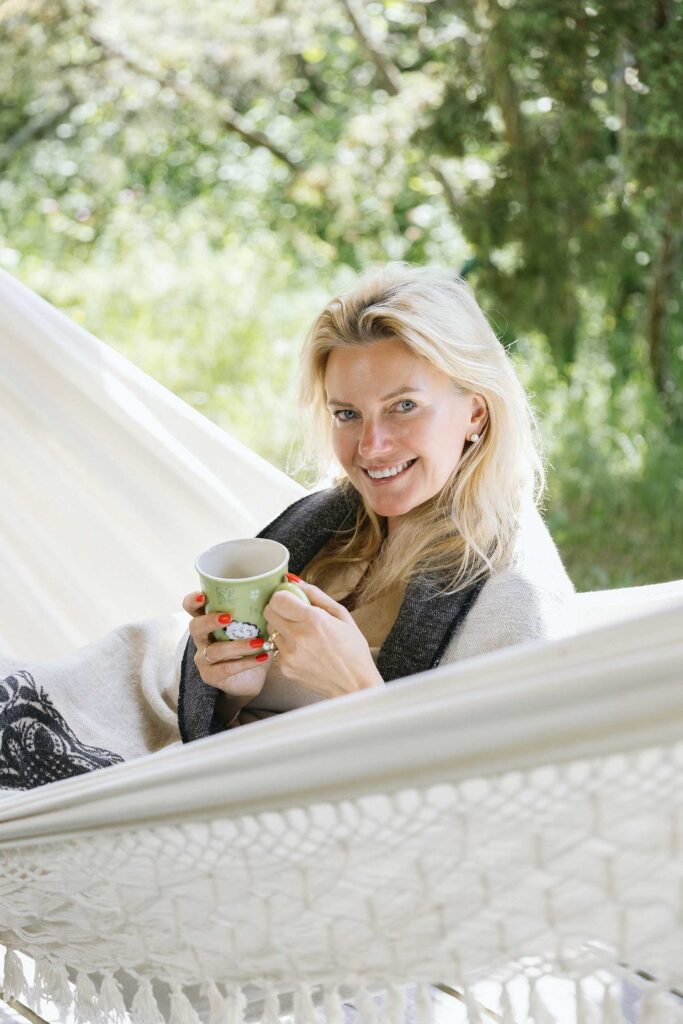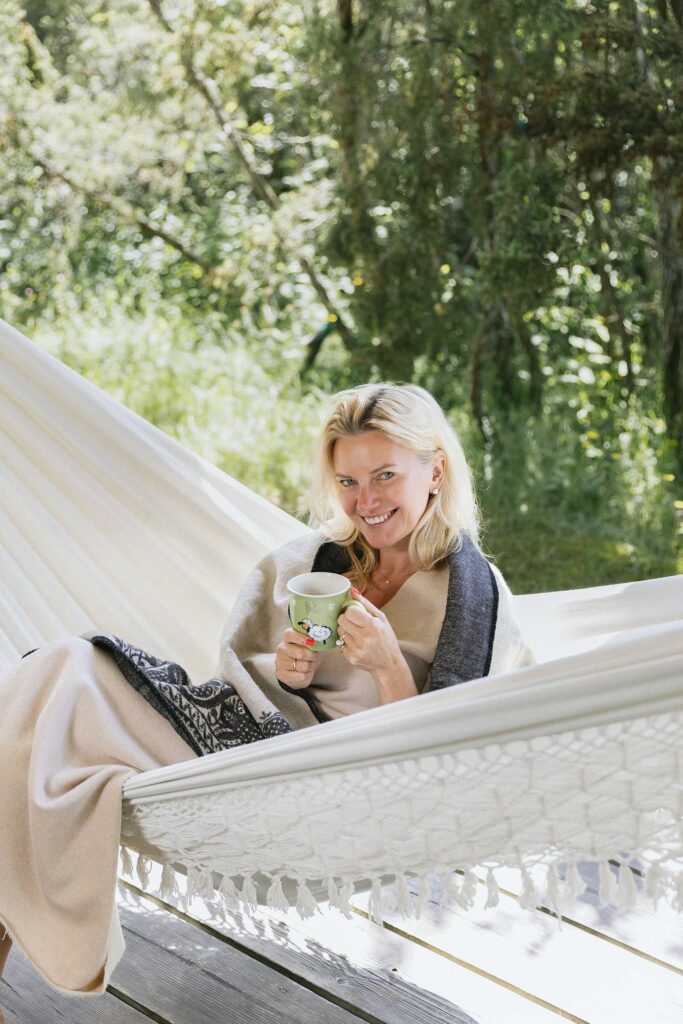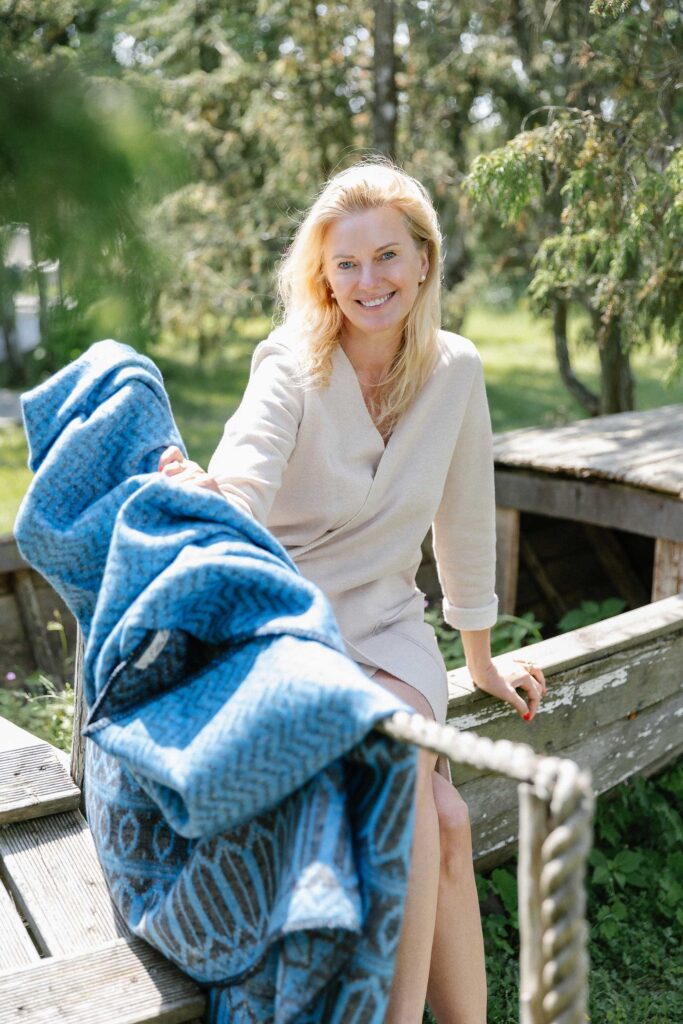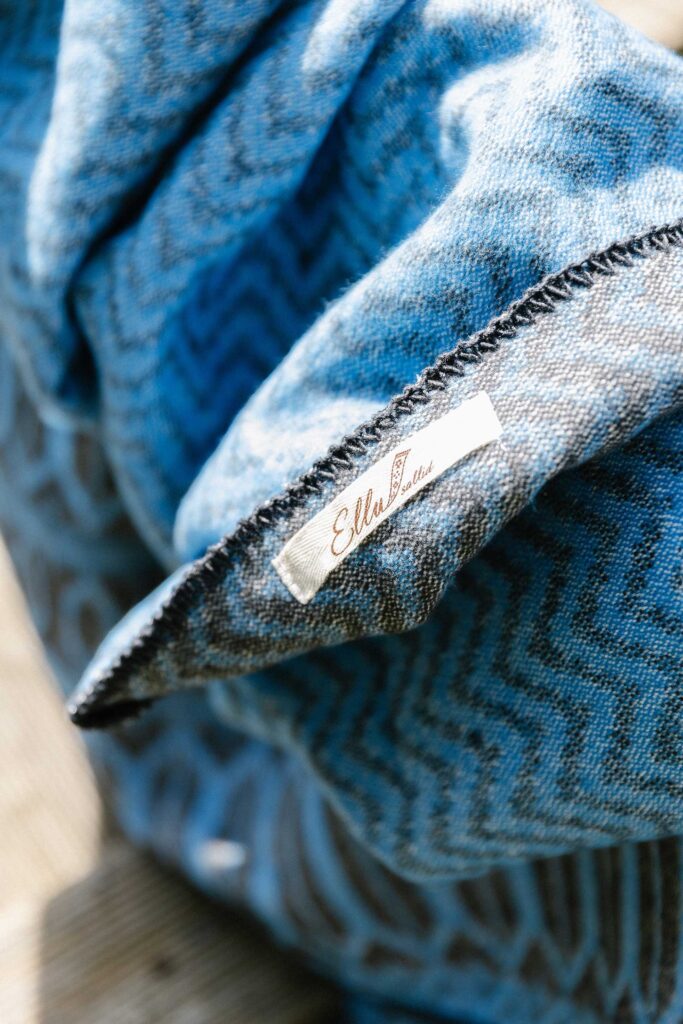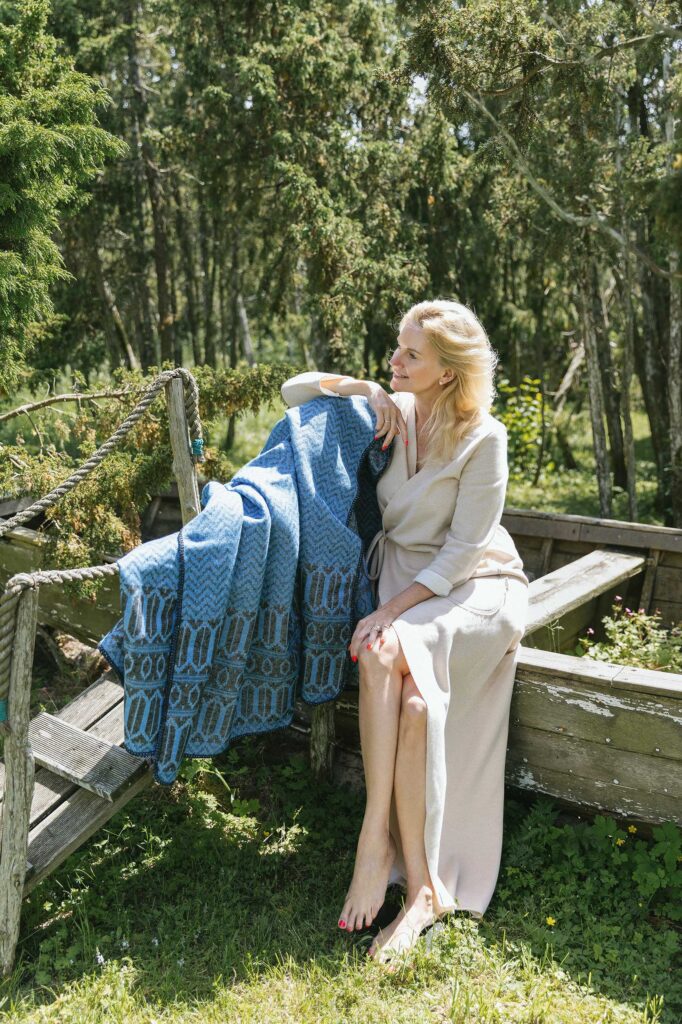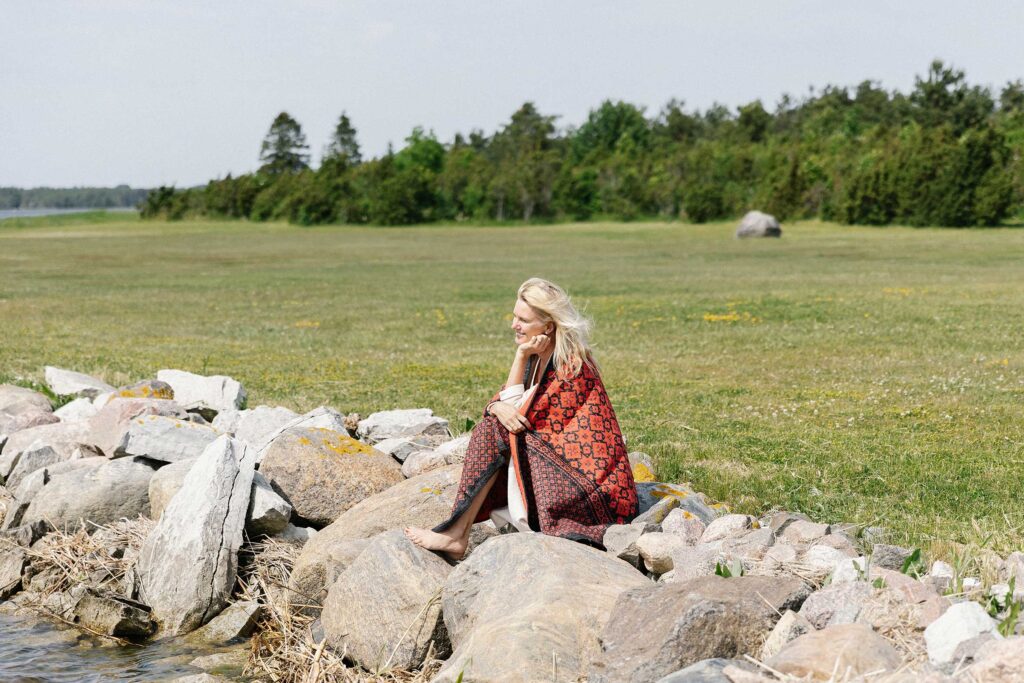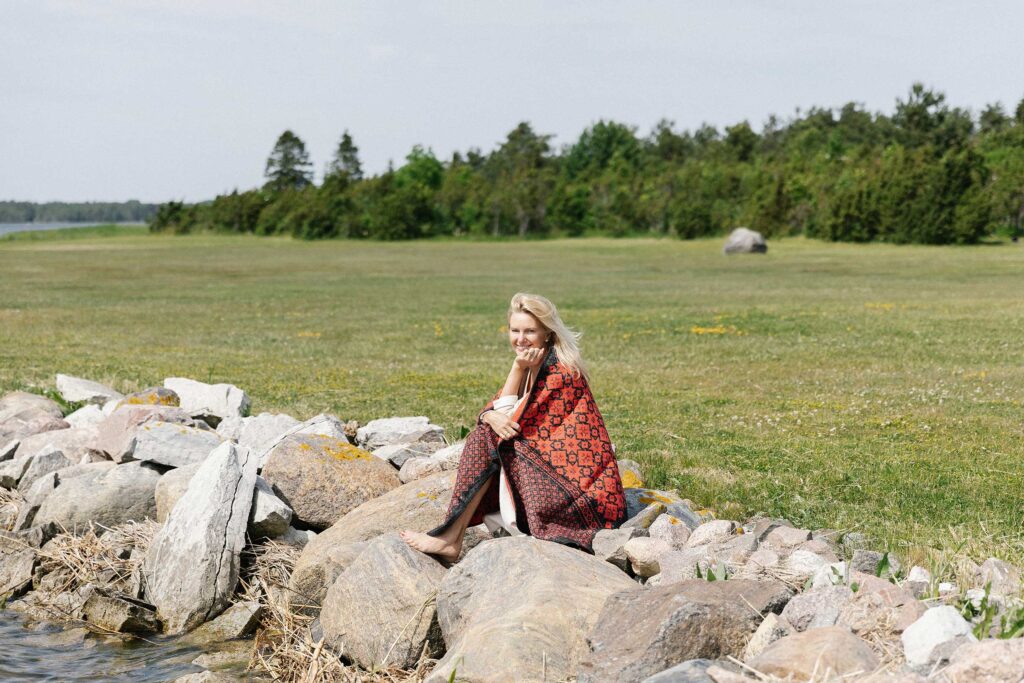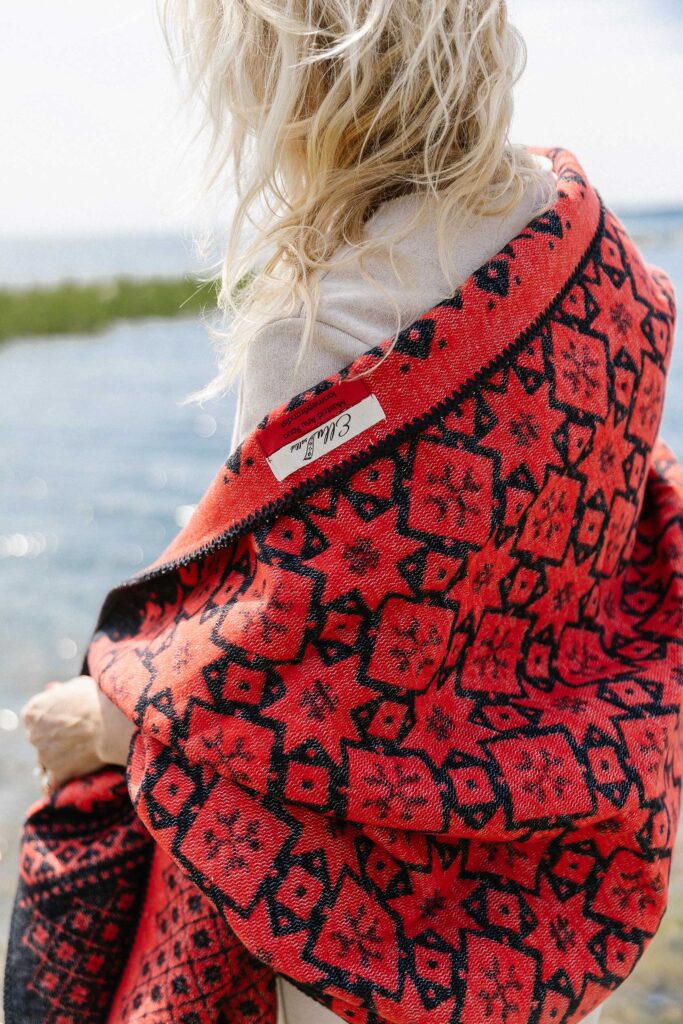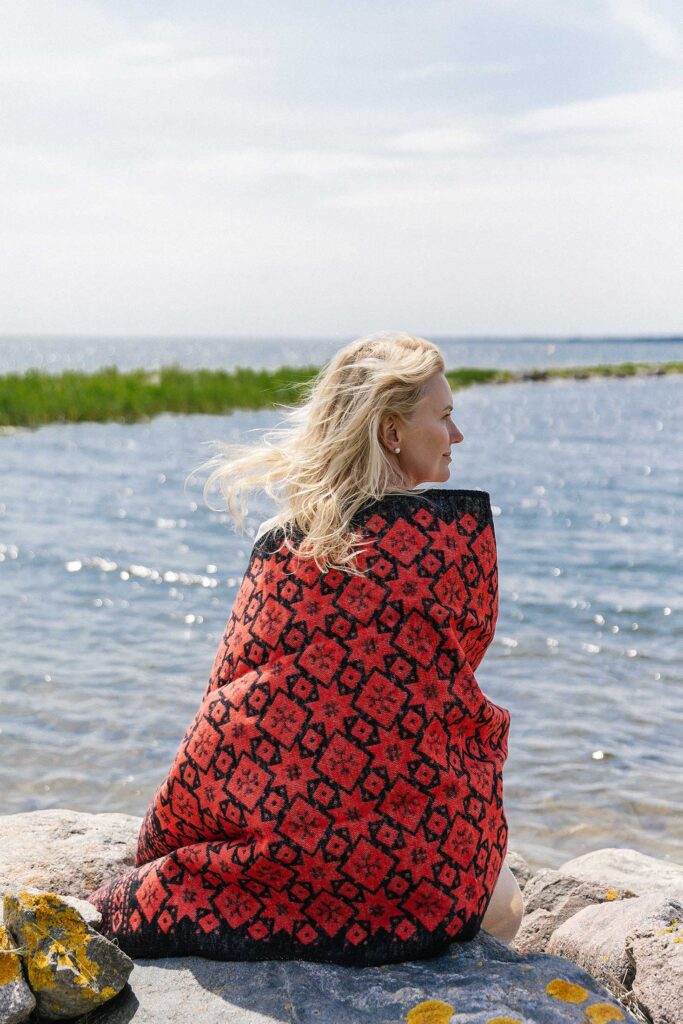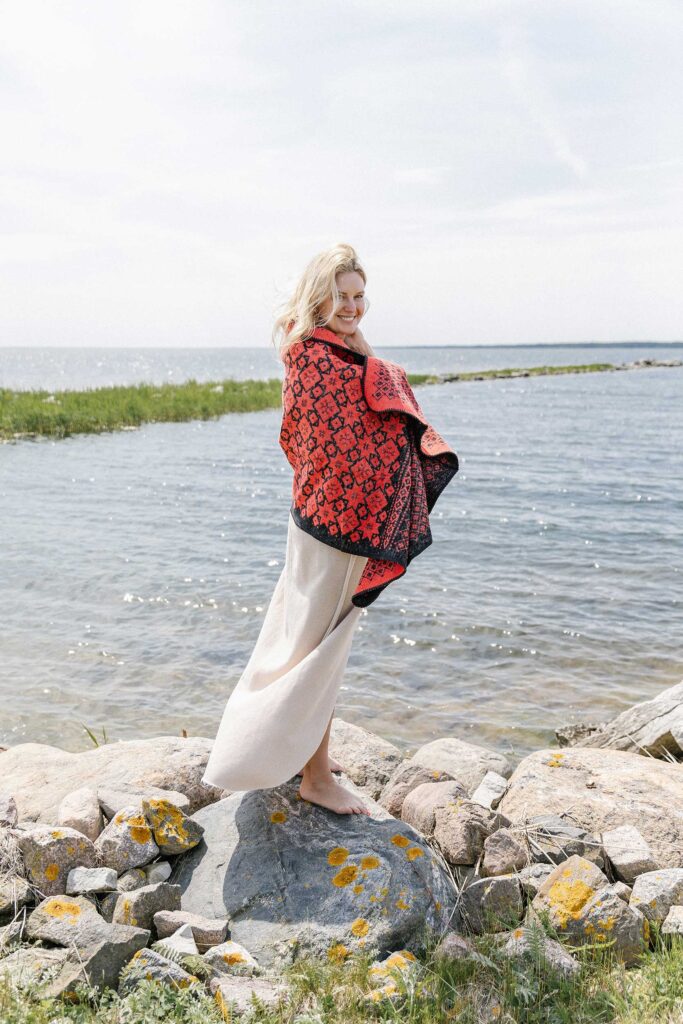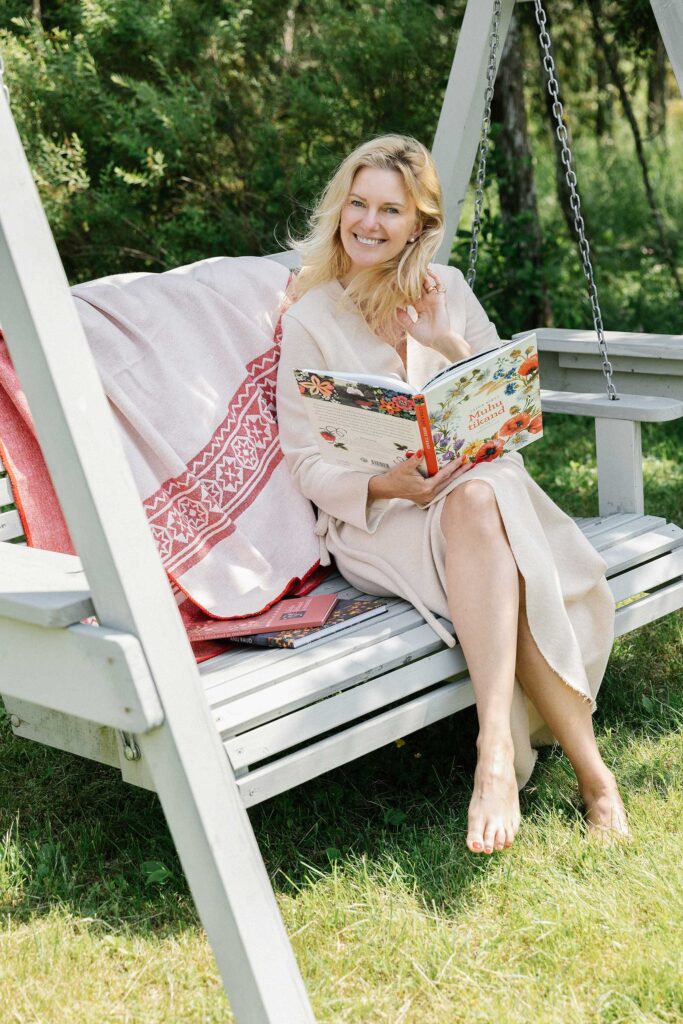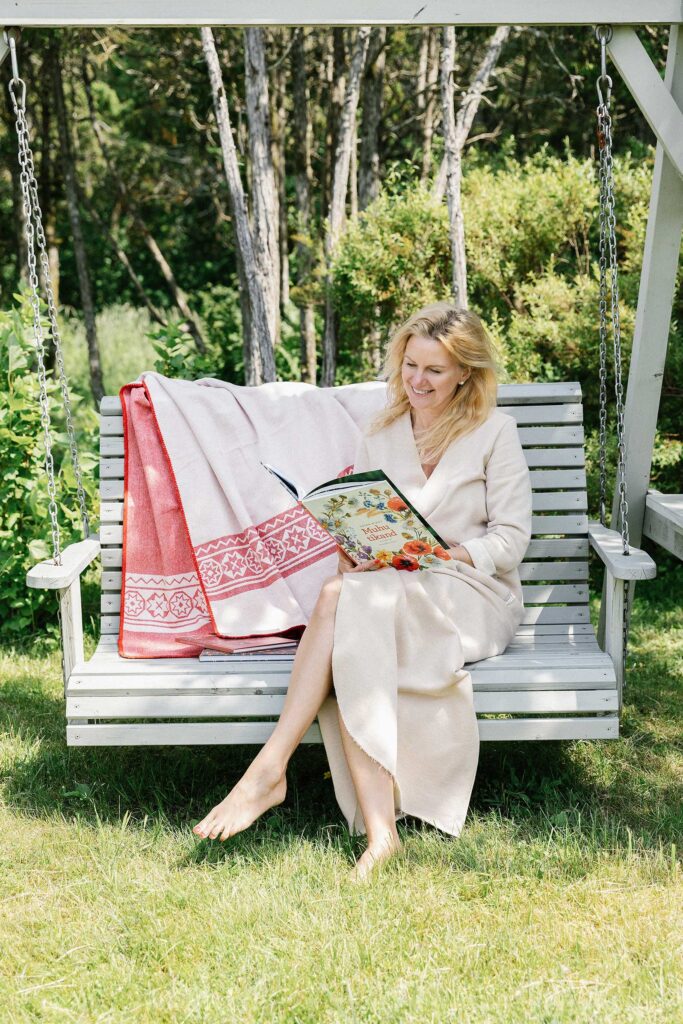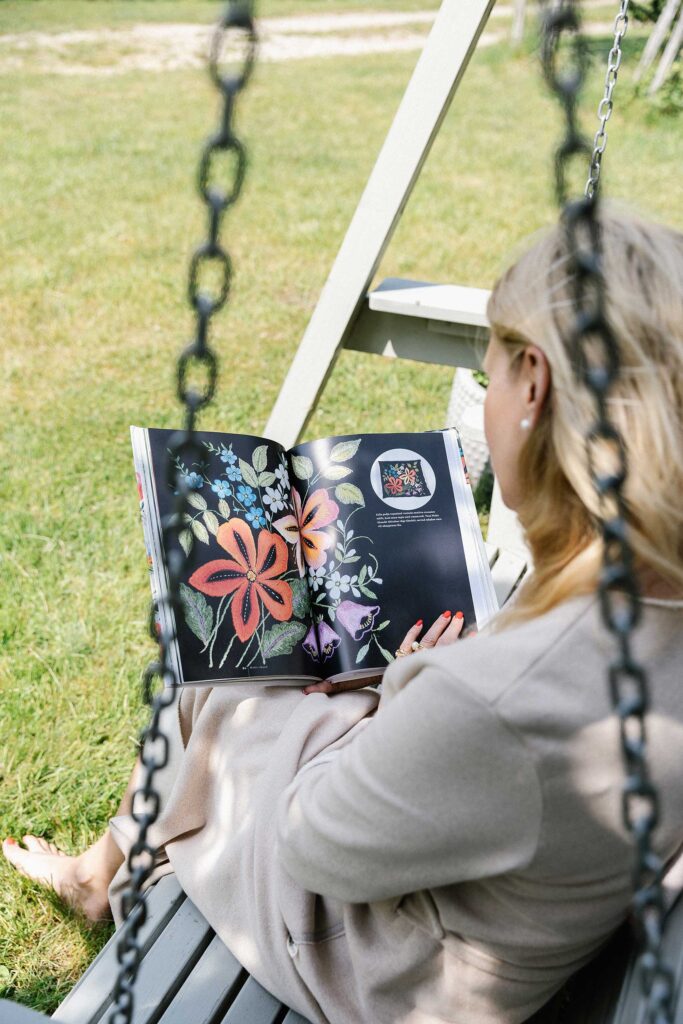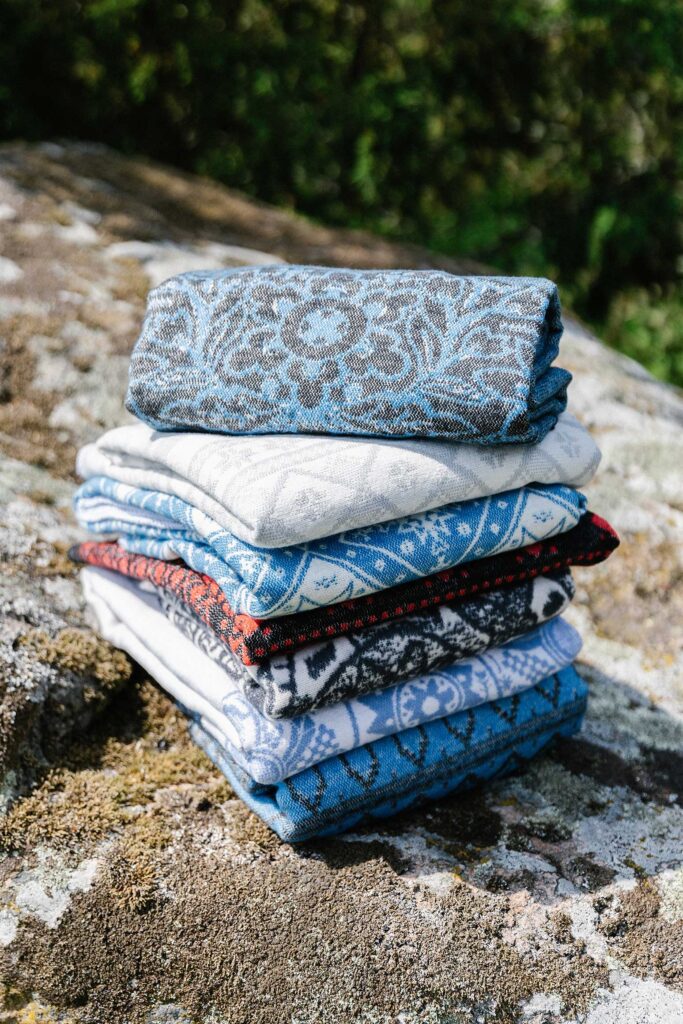On a sunny summer’s day, amidst junipers and the whisper of dragonfly wings, we spoke with Helen about how scarves imbued with powerful traditional patterns are born – scarves that warm the heart and carry forward the stories of our foremothers.
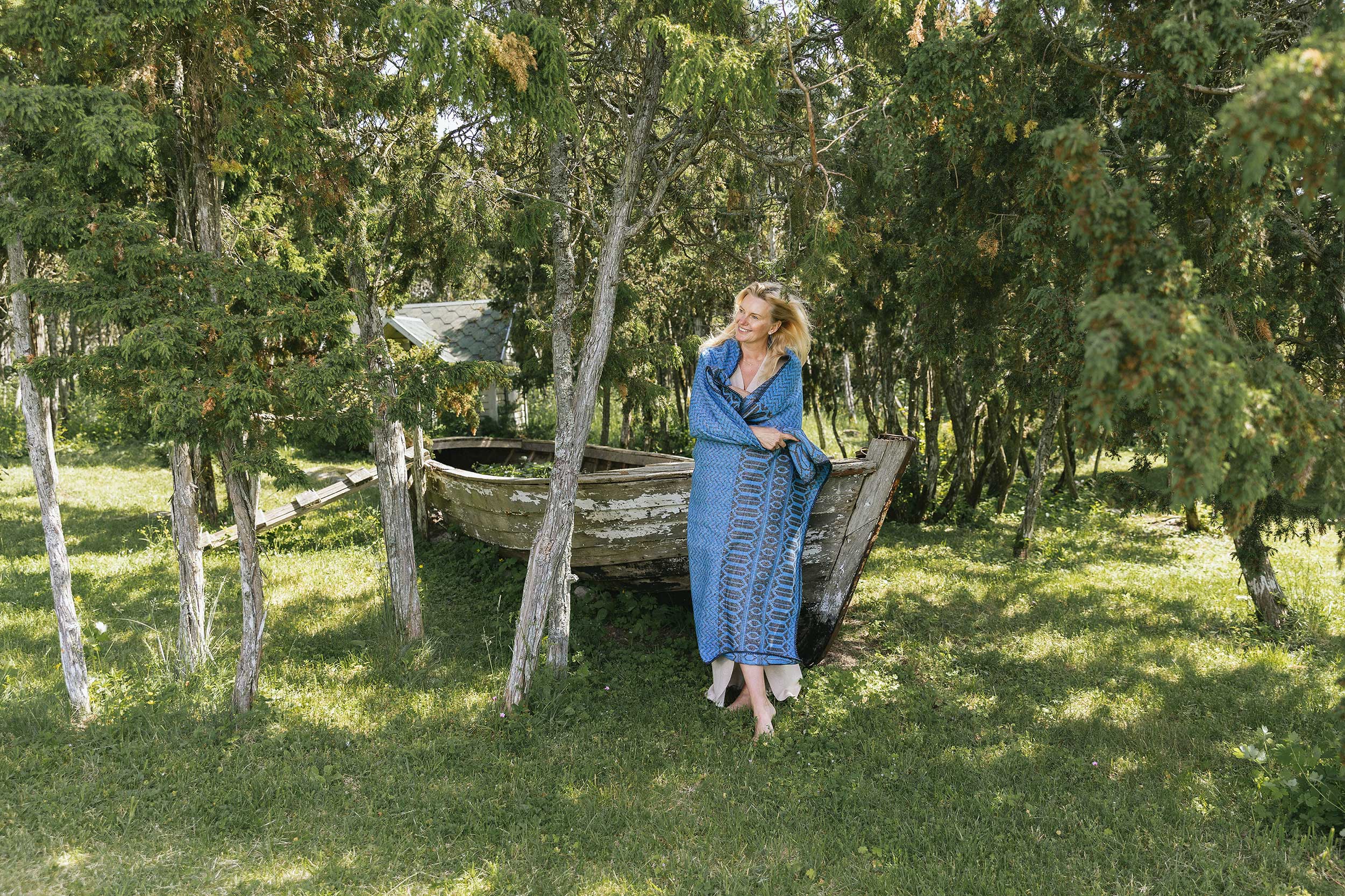
Ellu Scarves: Patterns of Power from Our Foremothers’ Treasury
26.06.2025
This time the Artist Series project takes us to Hiiumaa to meet Helen Vaks, the creator of Ellu scarves, whose work blends a deep respect for folk heritage with a unique artistic signature.
How did you come to create the brand?
Exactly 15 years ago, in June, I was sitting at a men’s folk dance festival in Rakvere, where my son was performing. The weather was windy and slightly rainy. From the stands, I watched the dancers trying to protect themselves from the rain with jackets in all kinds of colours. And I thought, “Goodness, we already have “sõba”! ”
I myself danced folk dance for ten years and remember well that traditionally, a “sõba” – a type of ceremonial shoulder shawl – was part of the national costume. Sitting there in the stands, I realised that we’re actually missing them. That was the spark that started everything. The first ten patterns were completed that autumn, and by Christmas, the first products were ready. Ellu scarves are adorned with stylised versions of beloved Estonian patterns, following the wisdom and skills of our foremothers.
Did your interest in traditional patterns begin with the brand, or earlier?
I had been involved in folk dancing for a long time, so I already knew quite a bit about national costumes. There was a strong sense that I wanted to pass on something familiar and dear. Naturally, the creation of the scarves and patterns was preceded by thorough research – I gathered material from the Estonian National Museum, the Open Air Museum, and other institutions. It was a long but fascinating journey.
Have there been any collaborations or commissions that are especially memorable?
My work has been incredibly exciting – from discovering patterns to interpret myself, to fulfilling meaningful commissions. Museums have requested patterned throws and scarves; as have various folk song and dance groups. I always take on these projects with great enthusiasm.
One particularly touching story is the blanket for the Viimsi Coastal Folk Museum. The museum is housed in an old school building. There once was a father who couldn’t afford to pay for his children’s education. As a token of gratitude, he gave the teacher a family heirloom – a blanket. That very blanket still resides in the museum’s collection. I used its pattern for the museum’s commissioned blanket, as both the building and the textile carry a strong, emotional story.
I also collaborated for half a year with Anu Raud, resulting in three scarves. One of them featured a beautiful Kihnu mitten pattern I discovered at the Heimtali Museum.
A particularly warm and meaningful collaboration was with Epp-Maria Kokamägi, with whom we created the “Guardian Angel” baby blanket. I had long wanted to design a baby blanket, as very few of these exist in collections – usually, larger blankets were simply cut down to size. Since there was great interest in such items, I began thinking about whom to partner with. Epp-Maria is a grandmother herself and has strong ties to Pärnu County, which felt like the perfect match. I wanted to use a decorative collar motif from the region’s traditional costumes. The angel illustration was done by Epp-Maria herself.
One year, I collaborated with Katrin Kuldmaa on a dance festival scarf. As she has roots in the Mulgimaa region, she brought a deeper conceptual connection. The inspiration came from the traditional Mulgi coat.
Muhu wedding blankets have always deeply resonated with and inspired me. One grey blanket with floral embroidery was created in partnership with Marilin Sikkal. I was moved by a similar pattern, and when Marilin told me she had found a beautiful wedding blanket, we decided to bring it to life together.
In addition to scarves, I now also offer blankets and cushions for both sofa and terrace. Creating holistic interior solutions – indoors and out – is very inspiring.
What is the meaning behind different patterns and symbols in Estonian national textiles?
There are many meanings and symbols. People used various designs to convey messages, wishes, and dreams. Symbols were often infused with protective and magical qualities, aligned with the beliefs, superstitions, and aesthetic experiences of the people. In Muhu, for instance, blankets decorated with the “männakirjad” pattern (pine-pattern embroidery) were common, featuring symbols like the orderly eight-pointed star (octagram) and serpent mark. These blankets were laid on beds during the day and worn over shoulders in the evening when heading to village gatherings. The floral embroidery tradition in Muhu was introduced by women from Lihula who taught the craft to locals.
Red was believed to be a protective colour, guarding against the evil eye. The eight-pointed star, also known as the North Star, is a strong protective symbol – representing luck, renewal, and guidance. It appears widely across Estonia and the Nordic region and was frequently used in blankets and shawls. The serpent motif also holds powerful protective magic.
In Southern Estonia, shoulder wraps were often adorned with distinctive diamond-shaped patterns called “sõõr” – a design that evolved into the well-known circle motif.
Our foremothers drew inspiration from nature. Natural dyes were used – red from madder root, black from juniper berries, and so on. If you look at the floral embroidery from places like Lihula or Muhu, you’ll see nature in every stitch – poppies and our rich array of field flowers.
Is there a pattern you've dreamed of creating but haven't yet?
Definitely. One that fascinates me is the beautiful lace from Hiiumaa. A bit of that motif already appears in the “Power Women’s Scarf”, where the legendary women of Leiger and Suur Tõll – Piret and Tiiu – meet. It’s a powerful story that connects Hiiumaa and Saaremaa.
I’m also deeply drawn to the embroidered bonnet patterns from Saaremaa – they’re full of meaning, beauty, and strength. My own collection includes many Southern Estonian motifs, which are always rich in symbolic power: the circle, the tree of life, all those strong signs.
Which pattern has recently come to the forefront?
For example, this one – the Rõuge shawl pattern, which originates from the Estonian Open Air Museum collection. It became the official shawl of this year’s song and dance celebration. I wanted to create something slightly different. Though Ellu scarves are said to have a recognisable style, I felt like going in a new direction this time. The pattern comes from a tiny preserved piece of a blanket, featuring the serpent mark and the circle – both deeply tied to Estonian strength and symbolism. Because creating a “sõba” requires far more skill than many other garments, they were treasured and passed down through generations. This is the story behind the Rõuge shawl too – only a small fragment remained, and from that, a rebirth took place.
How much of you today is an entrepreneur, and how much a creator?
I think it’s quite balanced, since I run the Ellu scarves story on my own. But at heart, I’m definitely more of a creator – I love my work and do it with great passion. I have three children, but people often say Ellu scarves are like my fourth child. I do it all with great heart. It’s my mission, my story.
People seem to sense that – many have said that an Ellu scarf, with its patterned power and the story leaflet that comes with it, radiates great care and dedication. Customers truly value that, and perhaps that’s one reason why Ellu scarves are such a beloved gift.
Being an entrepreneur isn’t easy nowadays. Global events affect us as well, even down to the yarn spools. I’ve had to wait for materials in autumn and winter. Designs were ready, but I didn’t know if I’d be able to realise them, as even knitting companies have been shutting down. It’s also difficult to find skilled workers – like those who hem scarves or cut fabric.
Thankfully, I’ve made it through all the challenges so far. My customers, who are passionate supporters of Ellu scarves, give me tremendous strength. Without them, the journey would be much harder.
People say Estonians keep everything to themselves and don’t express feelings – but I disagree. Through these scarves, which carry our foremothers’ stories, people are very willing to share their thoughts and gratitude. Scarves have been gifted at weddings and jubilees – these stories truly move people.
You do a lot of groundwork for each scarf. How long does it take from choosing a pattern to the finished product?
On average, about half a year. Sometimes the process is quicker, but other times it takes longer – especially if a dance group wants a shawl, and I need to find a pattern that fits their particular folk costume. I research what shawls have been used in that region and explore collections to revive the right design.
For example, with this year’s Rõuge shawl for the song and dance celebration, I went directly to the Estonian Open Air Museum’s archives. While opening drawers there, one distinctive and intriguing pattern caught my eye. Until then, I had used mostly floral motifs, pine patterns, octagrams, figurative elements, and bonnet embroidery, but this time I felt drawn to that specific design and wanted to preserve it.
Many customers have said later that reading the background stories of the shawls on my website has been truly fascinating and educational. Most people don’t even know exactly what a “sõba” is – they may know the phrase “sõba silmale” (a folk saying, meaning sleeping), but not the broader meaning. There have been many names for such shoulder coverings in Estonia: “suurrätt, õlalinik, vaip, sõba, tekk” – it depended on the region and size.
My aim is to convey the story of each region through its shawl, always including a detailed product leaflet. As I mentioned before, “sõba” was part of festive folk attire – worn on holidays and to church. They were the ceremonial shawls of married women. In the past, they were made of wool; Ellu scarves are a cotton-linen blend.
What role does Hiiumaa play in your creative work?
My roots are in Hiiumaa, and I always feel at peace here. The quiet, the birdsong – it all creates the perfect environment for creativity. It’s here in Hiiumaa that I write my product leaflets and often sketch the patterns for the shawls. It’s where my creativity flows most freely.
I’ve created scarves dedicated to Hiiumaa, inspired by childhood memories with my grandparents. The ideas that emerge here are different from those in Tallinn, where life is more hectic. While I’ve found inspiration in Tallinn too – in libraries and museums –Hiiumaa is my deep, quiet source of true creative energy.
Do you have a special place or ritual in Hiiumaa that nurtures your creativity?
I love being in nature – walking among junipers, sitting by the sea, or simply being in silence helps patterns unfold in my mind. One of my favourite rituals is the Hiiumaa sauna followed by a dip in the sea – there’s something purifying and calming about sauna culture that clears the mind. Sääretirp is a place that always inspires me. But most of all, my creativity blooms here at home, in the peaceful presence so unique to Hiiumaa.
If creativity never stops, even in rest, how do you recharge?
In a way, I’m always creating. Whether it’s the books on my table or visits to museums – there’s always something that sparks an idea. I constantly carry undeveloped ideas in my head and think about how to bring them to life. Sometimes it’s about finding a technical solution, especially in knitting.
I’ve collected so many beautiful and intriguing patterns, but some are waiting for the right technology – nowadays it’s very difficult to find machines capable of knitting figurative elements. That’s why some designs are simply on hold.
I don’t recall ever needing a creative break. My work is such a natural part of me that I don’t feel the need to rest from it. With all the dance troupes, municipalities, and communities placing orders, it keeps me engaged and fuelled creatively.
When someone buys an Ellu scarf, do you hope it evokes a specific feeling, or is it open to interpretation?
Some people look for a scarf that represents their birthplace, others are drawn to a pattern that reminds them of a cherished memory. That’s why Ellu scarves’ slogan is: “Hugs from a beloved place.” People have emotional ties to certain regions, and it’s important to me that everyone finds a scarf that resonates with them. It doesn’t have to be from their hometown, but it has to speak to them.
As I mentioned earlier, many people choose a scarf with their home region’s pattern – either for themselves or as a gift. Others are moved by the powerful symbols woven into the fabric. I’ve received heartfelt letters saying that when they wrapped the shawl around themselves, something shifted inside or in their lives. These are beautiful stories. People have shared how the scarves brought back childhood memories or awakened emotions. They’re touched when I’ve created something meaningful for them. It brings me joy!
Scarves are often given to Estonians living abroad – they resonate and connect. As the patterns include healing symbols, people say they feel there’s something special in them – a kind of energy, as if the power of foremothers has been woven into the threads. It’s as though the scarf offers strength and protection.
Of course, the moment and life stage when someone receives or chooses a scarf also plays a role.
How do you stay motivated to grow the brand?
I’m lucky that my work excites me and makes my eyes light up. What keeps me going is knowing that what I do truly matters to people. Being present at events and song festivals allows me to directly sense what people value and need. Ellu scarves are deeply personal, because Estonians have strong connections to their roots and home regions. When someone finds a scarf, shawl, or blanket with a pattern from their home area, that’s my greatest motivation. As Anu Raud once said: if we don’t preserve our own cultural heritage, it will disappear.
Support comes directly from people – from dance and song groups, communities, and individuals who write to ask what’s new. Last year at the Tartu Hanseatic Days, a woman told me their kindergarten held an Ellu scarves exhibition because so many families own one. Moments like that give incredible strength and affirmation that I’m doing the right thing.
I’m also endlessly inspired by the world of patterns – it’s a bottomless well of ideas. I visit museums, exhibitions of folk costumes, and flip through pattern books, always seeking new motifs to share. I’ve used patterns from shawls, bonnets, sleeve decorations, belts, and garters – whatever speaks to me.
Each scarf comes with a detailed product leaflet that tells the story behind the pattern. That’s very important to me, because I want to expand people’s understanding and share our foremothers’ legacy. In the past, women embroidered their wishes and dreams into their shawls – some longed for children, some for marriage, some for health. These weren’t just patterns – they were charms and protection. It was believed they carried power to shield the wearer.
All of this – the feedback from people, passing on cultural heritage, and the deep meaning in the patterns – keeps my motivation alive. This is my story and my calling.
What advice would you give to a young designer who wants to create something personal influenced by national motifs?
I would be truly happy if more young designers joined in and continued this story. We have so many wonderful patterns in Estonia – I’ve only touched a small part of them. I wholeheartedly support their further use – whether in clothing, bags, interior design, or anything else.
And why not add a playful twist – interpret national patterns in a stylised way, adding personal flair. That would be very exciting and would enrich our design landscape even more.
Where is Estonian design heading?
I recently attended the anniversary of the Tallinn Design House and was delighted to see how many new designers have emerged. I’m genuinely happy that there are so many talented young people coming up – whether in fashion, footwear, bags, or interior design – Estonian design is growing and thriving. I wish them all success and endless inspiration.
What might be the next chapter for Ellu scarves?
I hope the next chapter will be easier. I wish for peace in the world, the end of war, and the restoration of material supplies. Right now, several knitting companies have closed their doors, creating challenges for my work as well. I have many new patterns waiting, and several commissions are ready to be realised.
In the future, I definitely see new patterns and stories ahead. I’ve also received some exciting proposals – but I’m not ready to talk about them yet. What I can say is this: I still have so much to give – beauty, patterns, and power to share with people.
